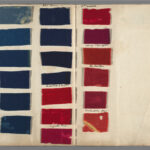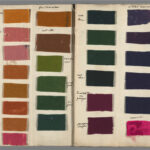Tapestry
The Gobelins was a royal manufactory dedicated to tapestry weaving and textile dyeing. Brilliant, permanent dyes were of crucial commercial importance, and presented a complicated challenge for chemists.
The pages of dye samples seen below are the product of research solicited by the French Academy of Sciences for its own projected publication on the arts and trades. Although not specifically related to Diderot’s endeavor (though Diderot and his colleagues knew the project well), the document is suggestive of the kinds of research undertaken for the Encyclopédie. Most of the names given to the color samples correspond to the list given in the article on dyeing in the Encyclopédie, where at least 80 different colors are listed for wool. Each was produced with a different dye.
- Dye samples
- Dye samples
- Dye samples
To further complicate matters, fibers of wool, linen or silk were affected differently by the same dyestuffs. Thus, two different dyes were required to achieve the same red in wool and silk. The complexity of producing colors did not lend itself to illustration. Instead, the plates are dedicated to the equipment and process of dyeing. In the plate to the left, bolts of wool are washed in cisterns before being moved to the dyeing vats.

Low-loom tapestry weaving at the Gobelins Factory: Workshop and the various actions of workers on the looms
The colorfast dyes perfected by the Gobelins helped to ensure the success of its tapestries and maintain their status as one of France’s major luxury exports. In the plate to the right, the various steps in low-loom tapestry weaving are depicted. Along the right wall, several weavers work at their looms, while in the left foreground others wind yarn or trace patterns. There was a social hierarchy within the 18-century world of work, and these artisans, in their knee breeches, stockings, frock coats, and powdered wigs were at its pinnacle. Far more humble in status are the dyers with their wooden shoes, and the needle makers seen in the plate below.
English translation of article on the Gobelin Tapestry in the Encyclopédie.





